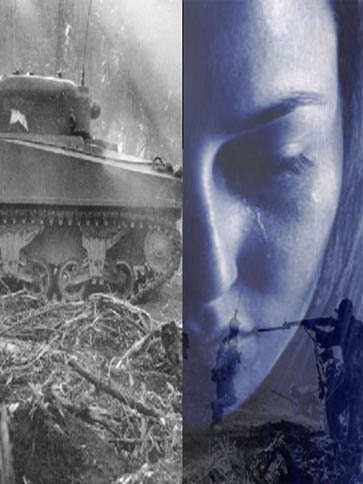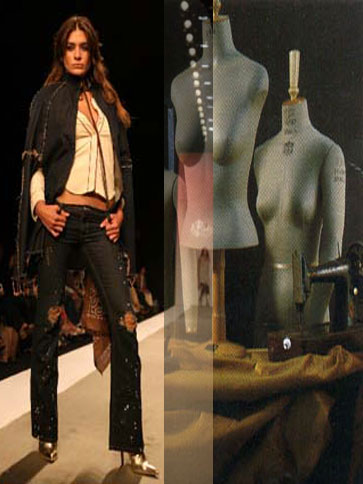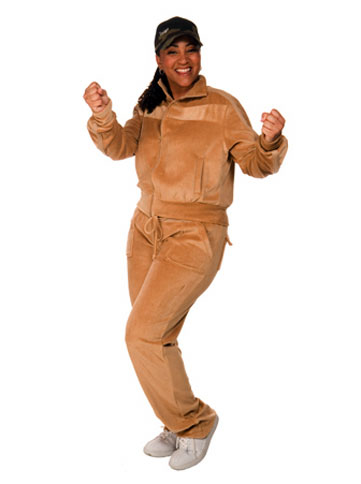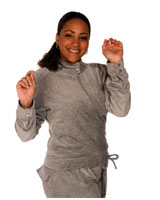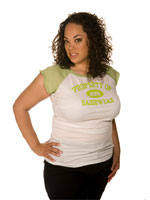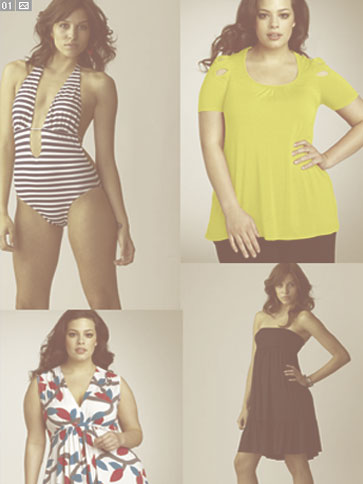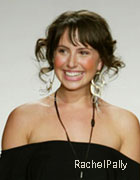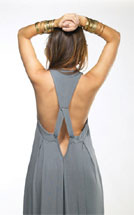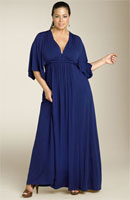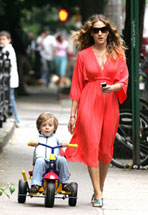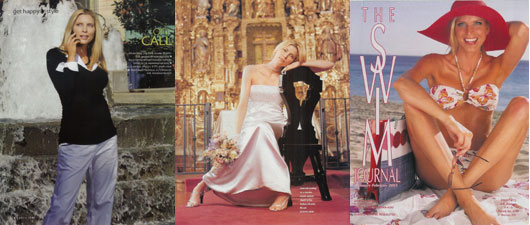Category: Spring 2008
Make the Most Out of Your Purchase
|
Make the Most Out of Your Purchase
This group of guests arrived to my “Good Girl Gone Shopping” launch party in celebration of my going forward with a new venture: helping individuals uncover their inner styles with personal shopping and wardrobe consulting. So in between cocktails being poured, hors d’oeuvres being devoured, and a table of male and female accessories being plowed through, I decided to show four different ways I could wear my new, red top (with the price tag kept on to prove that it was a real demonstration showing I have yet to wear it). With my own clothes, shoes, and jewelry set out on display, I illustrated casual and chic, casual and funky, dressy and sophisticated, and dressy with an edge. As I was talking to the group sitting on my couches, I felt completely comfortable and ecstatic that I was giving others ideas on how to make the most out of their purchases. I also gave each person a challenge: The next time they see a mannequin wearing a whole outfit they love, they should visualize how changing one piece would give the total outfit a different appeal. I also suggested that they refrain from telling the salesperson, “I’ll take the whole thing. I want exactly what the mannequin has on.” Whatever I do and wherever I go, I am always noticing how style is exemplified and how fashion is used to express one’s personality. Yet with so many factors that play into the decision-making process while getting dressed, I can’t help but wonder how many people fear wearing one of the favorite pieces the wrong way. Who Cares? That’s what I say in regards to playing around with a purchase. Exploring your options now is perfect timing! Springtime is pretty much here in Southern California; and shortly thereafter, the salty beaches quickly become the favorite go-to place (despite the heavy traffic on the 22 Freeway towards Huntington and the 55 Freeway towards Newport). There are already uniquely cut bathing suits in the stores, and the cutest darn sandals making their way on my must-have lists. So as I envision myself basking in the sun with Lucky in one hand and sifting through the grains of sand with the other, I will continue to enjoy the versatility of fashion. It makes me smile to think that someone such as Jacquie, my friend, co-worker, and new client, is looking forward to having fun with her outfits and steering away from playing it “safe.” Admitting that my services are influencing her new-found excitement to shop and stand up a bit more confidently, Jacquie is growing into quite the “stylista” simply by stepping out of her comfort zone and exploring her personality. I encourage everyone to do the same! If you’re a loyal “Talking Chic” reader, you may remember when I wrote, “The ‘F’ in Fashion is for ‘Fun'” after Britney shaved her head. Well, when it comes to exploring your options with your wardrobe, I think that pretty much sums it up. But O. K., so you take your favorite pink blouse and pair it up with your black and white pinstriped pants, and those bright blue shoes you just had to have, and walk through the doors upstairs to work. But soon enough, you feel completely silly. You feel foolish for thinking that you could pull off a look you always wanted to try out. But how else will you know what really works for you and what doesn’t? How will you ever truly feel confident in trying out new trends? Sometimes the worst stares and comments are the best comments you could get. This tells you that you’ve taken a brave step and tried something new. Incorporating a purchase into a full-blown outfit is what it’s all about. Although every item in your closet and jewelry box should have a special quality, sometimes you have to experiment and mesh new items together. It could be quite the explosion. Written by Elana Pruitt Visit http://www.diaryofapersonalshopper.blogspot.com andwww.myspace.com/talkingchic. |
Devon Ball of Saigewear – Designing Active Wear for Women of Size
|
Devon Ball of Saigewear – Designing Active Wear for Women of Size
The clothes I was given to wear throughout my modeling career were not attractive or appealing, and if I ever had the opportunity to make a difference for women of size I would. —Devon Ball— In an industry that caters to smaller sized women, Devon Ball has pioneered a line of active and leisure wear that is not only flattering but promotes healthy body image and positive attitudes. Ball purports that a lot of full-figured women don’t go to the gym because there is such a minimal selection of workout clothes available, that they just don’t feel comfortable working out in. She herself realized that the only time she felt comfortable during her fitness regimen was while she was wearing men’s sweats. Dispelling the myth that the average woman wears a size 5, Saigewear brings fashion to a starved and neglected population of women who deserve to look and feel good about themselves. I met Devon at the shop in LA that manufactures her t-shirts and was given a glimpse of what this entrepreneur did to get her line out into the world. All of us who are not a size 00 are grateful to you.
Thank you. I know how frustrating it can be when you’re trying to find something that’s flattering, feel confident in, or have clothes that you just want to go to the gym This is casual wear? It’s casual, leisure, and fitness. This clothing line can be used for the gym, or just for going shopping or to a concert. Designers have their own techniques of gauging sizes from different models. How did you determine the sizes for your line? When I first started Saigewear, I went downtown to different designers, and [I looked for] manufacturers that would distribute really nice fitness wear. Those clothes [I discovered] were not true to size. That led me on a very frustrating path trying to find manufacturers that could cater to that need. That’s what led me to the [realization that I would have to design these clothes myself]. That is what led me to Joanna Le, and I found Judy at Nancy LA because of that very issue. I needed someone that But it’s not just plus size is it? When I would go to festivals, or I am out selling clothes, or doing fashion shows, I decided to cater to everyone, and now the sizes will range from medium to 4X. Now what is a medium?
A medium is a 7/8 and we’ll take it to 4X, which is a larger size. If we have to go to 5X, I will, because I want to make sure that I am catering to everyone. So you have the background of a model and a fit model, too. So you know when things don’t fit. I am a former Ashley Stewart model. In fact, they were one of the [companies] that gave me my start. [As a plus size model,] I got knocked out of so many jobs because the things that they gave us to model just weren’t flattering. So imagine being in front of a camera and you’ve got on these clothes that are tight in the arms, loose in the stomach and they hang over on the neck. What do you do? You can’t radiate your true inner beauty. You’re not confident and you don’t feel at all that you can portray what they want you to. I got knocked out of a lot of jobs because of that. The most incredible thing I notice when I am having photo shoots for Saigewear is I don’t care who puts on those clothes, their figures are flattered, they look good, they feel confident, and it’s radiated throughout the pictures. So if you look on the Internet at the magazine pictures that we have [on our website], my models are happy, and they look good. What are some of the biggest areas you have to focus on when it comes to women’s bodies? I think the biggest areas are the middle section, the hips, the rear end, the height, and the length. And depending on if they’re top-heavy, it could be their arms are an What are your fabrics? Right now I’m using cotton, lycra, and there is polyester involved. I don’t know exactly what I am going to pick next, but these materials seem to work very well. Do your collections come out twice a year?
Well, right now they are coming out twice a year, but as Saigewear grows, I will be adding things in periodically. I am having so much fun, I am starting to see different designs that I can bring into fruition. As I grow, so will Sagewear. Where can we buy Saigewear? Right now, it’s primarily Internet. However, I am in the process of meeting with buyers. I’m looking at Sears, Macy’s, Lane Bryant, and Ashley Stewart. Highest High
By just being a former [plus size] model, my passion has always been there. Before, I was always a size 4 to 6. Once I became plus size, my ‘high’ became greater than me. It’s almost like I have been instructed to create this [line] to help women want to get in shape, feel good about themselves, and to look good while doing it. You’re going to help a lot of women’s self-esteem. That’s exactly what I want to do. Saigewear actually started as a day spa. This started back in 2003. Getting $200,000 at that point wasn’t conducive to SBA’s thoughts at the time. They didn’t believe in it; so I kept downsizing, and I pulled out the boutique part, because Saige will eventually be a spa where people enter and regroup, refocus, get the inspiration they need to go out there and be all that they need to be in the world. So this is the very ground level of Saige. Lowest Low I was listening to Russell Simmons Do You!, and was just blown away because I think everybody that starts a business venture goes through what he described—I completely ran out of finances. I put tons of money into [my business], and then I had to go through what worked and didn’t work. Had I known what I know now, I’d be so much farther along. But with tenacity and hanging in there, the most incredible things have shown up to get me to the next point. So when I’m at my lowest low, I may get down for a minute, but I am not out! What advice would you give to other entrepreneurs starting a business? Really hone in on what it is you’re trying to do and make sure that it’s your passion, because if it’s not your passion, you will not stick with it. This is my passion. And the only reason why I can stick through the fire and the brimstone of it all is because it is my passion. Surround yourself with people that are positive—that are going to help you to continue to see your dream, and people who are going to help you get to the next level. Stay away from a lot of negative energy, because that will only bring you down and help your vision to dissipate. When you’re doing something so great, you need to have very tight arms around you, because it’s not easy. Also, choose something that is going to help other people. I think that if there’s something you’re doing great, you can’t help but get it to other people. Try to surround yourself with people that have the knowledge. People that can understand your vision and can put you in touch with people that can help get you to the next level. Pretty much, just do all your homework, whether it is getting books from the library or finding someone who is already in the profession that you want to get into. School is never too much. They offer classes all the time on ways to help you get the skills you need. Most of all, pray! Saigewear was featured in LA Focus, Save the Date, and Senior Life. To learn more about Devon Ball and Saigewear, visitwww.saigewear.com. By Kaylene Peoples |
Rachel Pally – Designing for All Shapes and Sizes
|
Rachel Pally – Designing for All Shapes and Sizes
I remember that first collection. It was my very first time at Fashion Week, and I have to be honest, I expected stick figures in ‘unwearable’ garments to be walking down Rachel Pally’s catwalk. But to my delight, I saw clothes that even I could wear. Her collection was a women’s contemporary line, which utilized draping made from jersey to create sensual and beautiful tops, pants, dresses, and skirts. Ever since that day, I have been a die-hard fan of Rachel Pally’s designs. Imagine my sheer delight I’ve seen your work for quite a few seasons, and of course, I am a woman with curves. So your line really does appeal to me. How do you get inspired?
When did you get started? I started my business after college. I graduated in 2002 from Berkley, and I made a set of samples, carried them around, and found a new PR firm that was just starting and was able to take me on for next to nothing. Has your family been very supportive of your designing? My family has been very supportive. Nobody’s actually involved with the business, What caught my eye about your clothes, in particular, is that they are very figure-flattering for women of all figure-types. What made you decide to design for that particular type of body as opposed to…? The tiny contemporary shopper? Exactly. I make sure that in every season I have something for everybody. In fact, I [not too long ago] launched a plus-size line that is exclusive to Nordstrom. So saying that I was able to dress everybody in the contemporary market [isn’t true]. In fact, I was not able to dress everybody. So, I added the second division in order to make sure that I can dress a larger woman as well as 0-12. To me that’s super important. I feel there are a lot of lines out there that don’t cater to everybody and there are plenty of women out there who would love to find great fashions to make them look fantastic. Have there been any challenges in creating designs for plus size?
I really think it’s great. Like for instance with the Dove Campaign…
…And Tyra Banks having this whole backlash for those [unflattering] photographs, I think it is. We have to be realistic about what women look like, and how there’s no reason why women can’t find gorgeous clothes to wear that make them look great. There’s no reason a size 12 or size 16 or size 24 woman can’t look fantastic in her clothes. It’s nice to give that option to people. There isn’t another option. It doesn’t really exist in the market. In creating your designs, was there any one particular body type that you felt was more challenging? It’s definitely harder to fit the plus-size groups because women carry their weight in such different ways. But no, I work with jersey. It’s stretchy and you kind of make do. And not every piece is going to look good on everybody. But everybody in my office tries every piece on when we go through our sample fittings. We all have very different bodies, so it’s very important that everything looks at least good on everybody. It may not necessarily be the individual pieces we may want to purchase for ourselves, but it’s important to see that it works. Since I work with such a
So jersey is your main choice of fabric then? Yes. We’ve done other fabrications, including a cashmere line, accented pieces with satin, we did a fur holiday group, and there will be some changes. We will continue to add new elements, but for the most part it’s just jersey.
How well is the plus line that you launched with Nordstrom doing? So far we’ve done very well. It’s selling online at Nordstrom.com. We’ve gotten a great amount of feedback. But it’s going to take a little while because it’s a brand new idea for that market. It’s not just another cute line that is available in the What are your price points? The price points are about $150 for tops and about $250 for dresses. And it might be a little higher than that because it’s a little pricier than our regular contemporary line. Highest High
That’s a huge high!
Lowest Low
(Laughs) My lowest low was getting myself through reports today at Macy’s on the East Coast! It’s business, and there are times when there are lows. But it’s never been anything that you can’t recover from, luckily for me, at this point of my career. I just keep making it happen. I can’t get discouraged and you just keep pushing it through. The lows are very fleeting. The highs are very exciting. As a successful fashion designer, what advice would you offer to someone who’s up and coming and trying to also achieve the same success? I always feel like I give the same advice. If you are interested in becoming a designer and having your own business, go to college. No need to start and stop with design school. There are a lot of things you can learn along the way, but you have to have your brain trained to solve problems, act fast, and think quickly. That to me has been my biggest asset. I did go to school and I did work really hard and I trained my brain to be fast. I think that that has really helped me more than a design class. There are amazing designers who came out of design school, but for me and the path that I took, my education was the most important thing. What was your major in college? I did city planning, cultural geography, and dance. And I did very random things to have ended up in this industry. But at the same time, thinking is thinking. Do you think that because of the complex major that you had, this is why you’re able to think outside of the box and dress for all types of women as opposed to your standard? Having a dance background is the reason that I can dress for all types of women. I understand the body and I understand the way people move and I understand where things should fall and how things should drape—all based on costumes and based on movement. I’m sure some of it has to do with the diversity in my interests over the years. But I look at my collection and I think, “Wow, I was so clearly a dancer.” There are things in my wardrobe that look like things that I had to wear as costumes, and things that I would have loved to have worn, instead of other things. I feel like that’s where the roots are for sure. What’s next for Rachel Pally? I am just trying to continue to evolve and keep the line exciting. There’s a lot of competition in the jersey market. It’s nice to continue to offer exciting prints or exciting trims or different types of belts, accessories, and to make sure that we stay a step ahead of our game so that we can keep it fresh and keep our buyers excited. hel Pally, visit her website at www.rachelpally.com, and to purchase items from Rachel Pally’s plus-size line, visit Nordstrom’s stores or Nordstrom online. By Kaylene Peoples |
Lindy Flowers – Turning Modeling into a Longtime Career
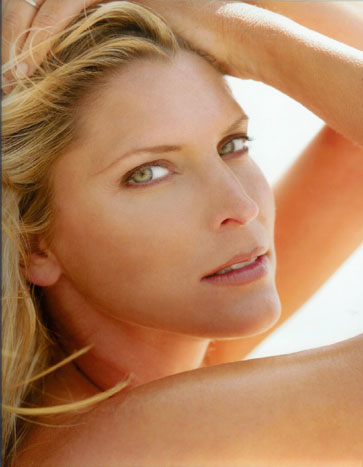 Lindy Flowers is a fashion model who has graced several magazine covers, been featured in countless editorials, is a runway model for Chanel, Donna Karan, Bill Blass, Oscar Del La Renta, Carolina Herrera, and Giorgio Armani, just to name a few. She has done umpteen runway shows for every designer imaginable. She has been steadily working for almost ten years in an industry whose average lifespan is only 3-5 years. And now Lindy is Agenda Magazine‘s spokesmodel.
Lindy Flowers is a fashion model who has graced several magazine covers, been featured in countless editorials, is a runway model for Chanel, Donna Karan, Bill Blass, Oscar Del La Renta, Carolina Herrera, and Giorgio Armani, just to name a few. She has done umpteen runway shows for every designer imaginable. She has been steadily working for almost ten years in an industry whose average lifespan is only 3-5 years. And now Lindy is Agenda Magazine‘s spokesmodel.
Hello, Lindy, and welcome to the Agenda Magazine Family. Would you mind sharing with our readers how long you have been modeling?
My first experience in modeling started back in high school when the most popular girl in school, Jessica, was taking a class at one of the local modeling schools, and I decided I wanted to be cool and popular like her. So when she asked me to take the modeling class with her, I decided to do [the six week] class, and it gave me a taste of the modeling world. I never thought that I could continue modeling and that it would be a career for me until one summer after my first year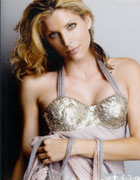 of college. The boss’s son at a company where I worked asked me to shoot with his photographer friend. I just thought he was trying to hit on me. But his friend came through, and we had the photo shoot. I got some free photos out of it, and he took the photos to an agency. . .and it started from there.
of college. The boss’s son at a company where I worked asked me to shoot with his photographer friend. I just thought he was trying to hit on me. But his friend came through, and we had the photo shoot. I got some free photos out of it, and he took the photos to an agency. . .and it started from there.
What are some of the things you’ve actually done as a model?
Modeling is awesome. It’s been an experience to learn about different cultures, about different people, a variety of different things. I have had the opportunity to travel overseas to places like South Africa, Thailand, Korea, Japan, Taiwan, as well as the European markets, too: Paris, Vienna, Spain. These are opportunities I never would have gotten in my everyday life.
Aside from being well-traveled, you’re quite the package.
I like to think so (she laughs). At least I sell that to the agents and the clients in the industry.
What’s your favorite kind of modeling?
I like the variety that modeling has to offer, but I’d have to say ultimately that print work is fun. It’s creating a finished product that I like to see.
Are there any perks to modeling? Have any designers ever given you one of their designs?
Yes, in fact that is one of the perks of modeling. I had met Donna Karan. I had done her fashion show in Beverly Hills, and after the show, four of the models [I was one of the four] stayed behind for the press. We shot pictures standing next to Donna Karan in her creations while the press was shooting her. At the end of it, she gave us the boots that we wore in the show. I had never seen models change so fast. . .and we have to change fast in the shows. . .but we changed so fast so that she wouldn’t change her mind. She gave us those beautiful boots that I still have to this day and will cherish because it’s one of my favorite things I have ever gotten.
Let’s talk about the print work. What are some of the magazines you shot for?
Pregnancy Magazine was my most recent magazine. I was pregnant with my second child, and that was really fun, just to know that I could continue modeling while I was pregnant, 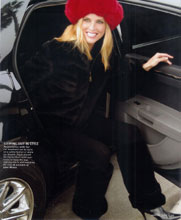 and to do something as wonderful as a pregnancy magazine cover. Other magazines range from Cosmo to local magazines. I shot South African magazines. Each country has a different set of magazines like the Vogues and the Bizarres. I have yet to do aVogue. If anybody out there from Vogue would like to shoot me, hey, I’m all yours.
and to do something as wonderful as a pregnancy magazine cover. Other magazines range from Cosmo to local magazines. I shot South African magazines. Each country has a different set of magazines like the Vogues and the Bizarres. I have yet to do aVogue. If anybody out there from Vogue would like to shoot me, hey, I’m all yours.
Is there anything particularly difficult about modeling, or does it all come naturally to you
At a time when most people would quit, I was told my nose is too big, or I’m too skinny, or too fat, etc. The negative aspect is the most difficult part. And the emotional part—to be able to take the criticism. The part of being able to be who you are when most people are telling you that you’re this way or you’re that way. And that’s probably the most difficult part of it.
You have a baby, and you don’t look like you’ve had a baby at all. What is your secret to staying in shape? You look amazing!
Thank you. I have been very blessed genetically, because with this being my second baby, I was not quite as lucky. So the first time in my life I learned how to use a treadmill. It’s a funny story. As I was standing there trying to use the treadmill, pushing the buttons [with no results], I was hollering to the guy, my treadmill’s broken. Well, it just started up. I didn’t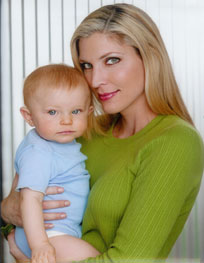 realize there was a countdown. So I’m still learning how to work out and stay in shape. I did play sports growing up, but hadn’t done such a structured routine. I do yoga and a lot of walking, especially with the kids, just to get out and help clear my head. It keeps me in shape.
realize there was a countdown. So I’m still learning how to work out and stay in shape. I did play sports growing up, but hadn’t done such a structured routine. I do yoga and a lot of walking, especially with the kids, just to get out and help clear my head. It keeps me in shape.
Do you eat healthy food or do you just eat what you want?
Again, after having the baby. . .and I have met a lot of friends that have small children and are really into healthy food. . .and I’ve always been a fast food junkie, I’m finding that I’m not so much a fast food junkie anymore, and I think that that helps with my complexion, my overall feeling. It’s nice to have a strong core immune system and healthy food balance. So I have definitely stepped up. That’s not to say that I’m not going to swing through drive-through every now and then, but I definitely eat a lot healthier; and I am more conscious of it.
Well, you do have beautiful skin. Let’s talk about some of your runway work.
The show that I was the most excited to book was the Guess show. They had their big anniversary show and they brought all the designers in from Italy. My entire agency had gone on the casting, and two of us got called back, and I ended up booking the show. They used girls from all over the world. The sexiness combined with fashion. . .it was a spectacular night. It was a spectacular show. I was really sick that night. My dream. . .I landed this show. I was so excited. And before I landed on the runway, I was as sick as can be, but I ended up seeing the video from the show and it ended up turning out really nice. That was probably my most exciting runway show that I have done.
How has having children impacted your modeling career?
As a mom with two children, [and they are also becoming involved in the industry as well], I actually get more excited when they book a job than when I book a job. I’m not the stage mom, but I get so excited for them. Even if it’s just a shot in Parents Magazine, I’m bragging about that. It’s so fun to watch them cruise through the industry, too. And to be able to know what I know and be able to shield them from things.
Highest High
My highest high was being treated so well on a job that I did forWomen’s Value Magazine. It’s a South African magazine. I was here in Los Angeles, and they really wanted me for the shoot. They paid to have me come out. So I flew out there [to South Africa] and we stayed in the best of the best resorts. I felt like a super model. The photos were beautiful, and I made the cover of that magazine as well. That was such a high for me to see that cover, to be treated so well, and to feel so special.
Lowest Low
My lowest low was after spending a month in Aspen Greece, pounding the pavement and going on audition after audition and not booking a single job and thinking, “What am I 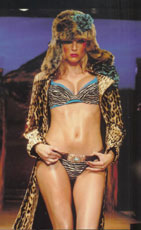 doing?” I had no money. I was the only model sitting in my apartment while everyone else was out on their bookings, and at this point the agency wasn’t giving me any castings because I wasn’t getting response. I thought, “Why did I think I could do this?” That was the lowest point. I overcame that of course by going home and regrouping and being amongst friends and family, and people that loved me and pushing through and trying again. It was a very humbling experience, because until that point, I had been working every market–they loved me, I had jobs, and it was extremely humbling. . .and I really needed that.
doing?” I had no money. I was the only model sitting in my apartment while everyone else was out on their bookings, and at this point the agency wasn’t giving me any castings because I wasn’t getting response. I thought, “Why did I think I could do this?” That was the lowest point. I overcame that of course by going home and regrouping and being amongst friends and family, and people that loved me and pushing through and trying again. It was a very humbling experience, because until that point, I had been working every market–they loved me, I had jobs, and it was extremely humbling. . .and I really needed that.
So what’s next for Lindy Flowers?
Well, Agendamag (she laughs). I’m really kind of moving forward and really enjoying the hosting, speaking out and talking with people, and sharing experiences. So I think I’m moving in that direction. I’ll continue to do the modeling. I love it. It’s my heart’s desire. I love each new booking that I get, and each new client that I meet.
By Kaylene Peoples
The Many Facets of Coco Johnsen – Her Next Stop, Designing!
The Many Facets of Coco Johnsen – Her Next Stop, Designing!
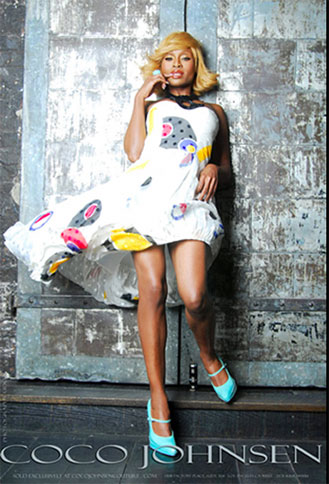 Coco Johnsen has graced the pages of countless magazines as a model, including Essence, Glamour, and Vibe. As an actress and former Lee Strasburg student, she was featured in the television shows The Parkersand Judging Amy, just to name a few. There has been some controversy surrounding the former model/actress regarding her affiliation with Playboy, but she has dispelled any untruths in her blog. After all, hobnobbing with celebrities like Anna Nicole Smith and Coolio, as well as constantly being sought after by paparazzi, do tend to make people exaggerate. Oh yeah, and she’s also writing a book. But I digress. The reason for this article has nothing to do with gossip columns or what someone may or may not have engaged in years past. My sole purpose of writing this article is to celebrate a person who has overcome adversity and has always landed on her feet. If I didn’t know better, I’d think Coco Johnsen has nine lives.
Coco Johnsen has graced the pages of countless magazines as a model, including Essence, Glamour, and Vibe. As an actress and former Lee Strasburg student, she was featured in the television shows The Parkersand Judging Amy, just to name a few. There has been some controversy surrounding the former model/actress regarding her affiliation with Playboy, but she has dispelled any untruths in her blog. After all, hobnobbing with celebrities like Anna Nicole Smith and Coolio, as well as constantly being sought after by paparazzi, do tend to make people exaggerate. Oh yeah, and she’s also writing a book. But I digress. The reason for this article has nothing to do with gossip columns or what someone may or may not have engaged in years past. My sole purpose of writing this article is to celebrate a person who has overcome adversity and has always landed on her feet. If I didn’t know better, I’d think Coco Johnsen has nine lives.
How do you explain being raised in an orphanage, spending her formative years in foster care, and dealing with the harsh realities of the deep South filled with provincial attitudes and racial intolerance? In most cases, you can’t. But Coco Johnsen has proven repeatedly that she is the exception to the rules.
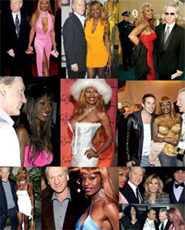 I interviewed a stylist a couple of years ago named Ty-Ron Mayes, who turned me on to a new designer named Coco Johnsen, who was launching her collection at LA Fashion week back in October 2007. Her spring 2008 collection was a big hit—again, no big surprise there. Everything this woman does is stellar. She not only has a successful clothing line, but she also designs shoes, and has an accessory line that includes high end sunglasses, belts, etc. Even her ad campaigns look like they have multi-million dollar budgets. So who is this mysterious chameleon? And what does she have to offer the fashion industry? A lot.
I interviewed a stylist a couple of years ago named Ty-Ron Mayes, who turned me on to a new designer named Coco Johnsen, who was launching her collection at LA Fashion week back in October 2007. Her spring 2008 collection was a big hit—again, no big surprise there. Everything this woman does is stellar. She not only has a successful clothing line, but she also designs shoes, and has an accessory line that includes high end sunglasses, belts, etc. Even her ad campaigns look like they have multi-million dollar budgets. So who is this mysterious chameleon? And what does she have to offer the fashion industry? A lot.
How did you get started as a fashion designer?
I decided that I wanted to go back to school. I had been a flight attendant for Delta Airlines for 13 years. I realized I was getting older. I was traveling a lot. So I got to see a lot of the world. I was moonlighting with my modeling career for 20 years. So I just wanted a little bit more, and I always was interested in design. I attended the Fashion Institute of Design, and it opened up a whole new world. I found an investor that was interested in helping, and it evolved from there. And here I am today.
Did being a model influence your decision to become a fashion designer?
Oh, definitely! Just traveling around the world and being in London and Paris, and especially for me, Milan, had a great influence on me when I was there. I didn’t have a very good modeling career there. I was too short. I remember going to a couple of the big agencies and being told, “Unfortunately, black models don’t work here.” And I told them I had friends in New York that were models and they did quite well. They responded, “Yeah, because they’re 5’11. We use them for shows.” So I was a little discouraged. I remember getting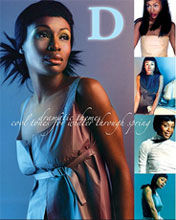 back on the plane and going back to New York really disappointed that they weren’t able to see that I could do lingerie or swimwear. And at that time in New York, there weren’t that many markets as there are now for swimwear models. There were lots of markets for hair products that were in the black market, or a limited amount of swimsuits. It was mostly work for video. So I just took what I had seen as far as gowns, and the beautiful dresses that I saw when I was there in the shops. I just used that and kept that in my mind to influence me for the future. I just kept traveling around and doing what I could do to see myself in the future past modeling. And that’s what led me to where I am now.
back on the plane and going back to New York really disappointed that they weren’t able to see that I could do lingerie or swimwear. And at that time in New York, there weren’t that many markets as there are now for swimwear models. There were lots of markets for hair products that were in the black market, or a limited amount of swimsuits. It was mostly work for video. So I just took what I had seen as far as gowns, and the beautiful dresses that I saw when I was there in the shops. I just used that and kept that in my mind to influence me for the future. I just kept traveling around and doing what I could do to see myself in the future past modeling. And that’s what led me to where I am now.
Tell me about whom you design for.
The Coco Johnsen woman is very feminine. She is an individual, yet she can go with the trend. . .but yet powerful. It’s really for a forward thinking type of woman who’s thinking, “I have this blouse now, and I want to be able to wear this next season.” What jacket can I make that’s going to accentuate what she has?
What are some of your fabrics that you use?
We use silk, silk dupiani, the finest cottons, and jersey. And in our fall collection we have wool. So we’re really thinking about giving you something that you can retain for a long time. And it’s a work of art. My last collection was very focused on the French renaissance period. A lot of our tops (tops with high collars), I made them so that if you had a jacket, it would accentuate what you were going to wear. Even if you were in the office during the day, you could take your jacket off at night to go meet up with someone at a cocktail party. So these are the kinds of things that I’m thinking about. I believe a lot of that influence comes from me living in New York City, and packing a lot of stuff with me, when I’m walking around the city and being able to pull my jacket out if I need to. Or put it on or take it off for an event.
Is Coco Johnsen couture?
Oh yes, definitely couture. Our tops range from $150 for our ready to wear. Our gowns range anywhere from $500 to $2,000 to $5,000. We have a dress that’s $12,000. And our clothes are manufactured in Brazil. The workmanship and artisans there need to be recognized. That’s the difference between a garment that you could buy at Macy’s, compared to something you can buy at Coco Johnsen’s. Not many people will be walking around in that garment. You know when you come to us, you’re going to have a top or pant that not many people will be able to have. That’s one of the reasons that we’re in that niche of luxury line.
How did you decide to become a couturier?
I always loved the couture pieces. Some of my favorite designers are Vivienne Westwood., Jean Paul Gaultier, and Chanel. When you’re living in New York City, you aspire to wear those clothes. Especially for me, having grown up in the South, it was my dream to be able to wear one of those tops or dresses. I thought, “Wouldn’t it be neat to be able to design in that way? Use the same types of fabrics and be able to [enable just about] anyone to purchase that, and not be so far above what you can afford?” That’s why we’re sort of falling in between the other designers in our price points. We’re trying to wholesale a little bit under what you might find from Chanel, Monique L’Huillier, or Kevan Hall. And those designers do inspire me.
What’s a typical day for Coco Johnsen?
I’m working on both lines now.  We started out with our couture collection Coco Johnsen, and then we added the ready to wear line Coco Johnsen Ready toWear. And then we added sandals with Swarovsky crystals. Every day could be a different project. Because of the time restraints with Brazil, it could take up to 6 to 10 weeks to get a garment back to us. So we are looking every day for new ways to make our products better, and to keep our price points as low as we can, but still make a profit.
We started out with our couture collection Coco Johnsen, and then we added the ready to wear line Coco Johnsen Ready toWear. And then we added sandals with Swarovsky crystals. Every day could be a different project. Because of the time restraints with Brazil, it could take up to 6 to 10 weeks to get a garment back to us. So we are looking every day for new ways to make our products better, and to keep our price points as low as we can, but still make a profit.
Do you do your own pattern making and sketching, or do you have someone that does it for you?
A little bit of both. Later on today, I’ll have a sketch artist come in and I will dictate what I’d like to see. Maybe change the sleeve or make the skirt length this season below the knee. Maybe sit with her for a couple of hours and flesh out what we want to have on the page, and she’ll go back and work on that on her computer. Then, she’ll come back to me. It can go through 2 or 3 revisions. I also sketch as well, but because I am the CEO of this company, I have so many responsibilities. I can’t sketch out every line as I would like to. And I don’t do patterns. (Laughs) Some people don’t do windows. I don’t do patterns! I can tell you exactly what I want to see or what kind of cuts I would like. The lines are very clean. For my last collection they were a little broader. And for every season I’m thinking about what I’d like to see. As a woman, I do take my own taste into consideration. I am not going to produce something or put something out that’s not going to flatter a woman’s physique. And I do take different sizes into consideration. Not only am I designing for a size 0 to a 2 to a 4 to a 6 and 8, but in seasons to come, we will be looking to design for our full-figured ladies size 12, 14, 16, and 18. We don’t want to leave them out.
Highest High
Our first fashion week at Mercedes Benz Fashion Week last season for our spring collection. I was exhausted, but it was a definite high to see what we had designed go down the runway. And the applause for the clothes—they really appreciate that we did something you could wear every day. Sometimes, myself included, I will only design stuff for editorial use. And sometimes it can be confusing to the consumer, if they’re looking us up to see what our collection was for that season. They think, “I can’t’ wear that.” I really wanted our first collection to reflect that we are thinking about what you’re going to wear every day, a special occasion. We did a 64-piece collection. Something in there should be right for you. No matter what size you wear. You’d be able to find something in the collection that would accentuate your wardrobe.

That’s a big showing for a first-time showing, too. That was very ambitious.
It’s always scary a little bit, because you don’t have anyone to really bounce that idea off of. The collections move so fast. I don’t think the public realizes that once a designer puts a collection out, they only have 3 months before they have to show their next collection. And that’s a lot of work. Some new designers will show a big collection like we did with 64 pieces and then they’ll skip the next season and then show you a next spring or fall. We’re actually putting out another fall. We’re limiting the collection in order to do it right, and to get the pieces forward that we believe are the strongest pieces for that collection. But it is a challenge every season. So I would say my lowest low would be realizing that we’re not able to do all of the things and produce all of the pieces that we initially designed. We may design 120 pieces, but the public may only see 64 of those pieces. And sometimes that’s a bit of a letdown. As designers, we have this vision of what we want to see and the pieces all interconnect. But there may be pieces missing from the collection that are either too expensive to reproduce, or because of the lack of availability, it becomes one-of-a-kind.
Did you experience any obstacles when trying to start your business?
How much time do you have! There are so many obstacles to overcome that I decided to write a book about it. My book is calledFrivolous and it’s about the industry coming from a model’s point of view. All these things that were happening to me like ordering fabric from a factory and you find out after you’ve made the garment, the factory is out of business, or the fabric’s not available. So you just learn as you’re moving and progressing into this business that there are certain obstacles that you cannot avoid. Because the fashion business is a frivolous business, finding funding is a challenge. Let’s say you put into a shop a garment that’s taken you 3 months to make, it’s a trendy garment. It’s gone. Next season it’s out. That fabric might not be in any more. So I try to design around that and not to make my pieces go out. You learn through designing and a lot of obstacles like spending a lot of money for fabric and then discovering that you can’t use it. These are things that you can only learn from being in the business. And the books that I’ve read [on the subject] don’t really touch on that. Or say for example, the back end part of it of having co-designers that you work with. Sometimes it doesn’t work out. Sometimes they want to have their name above yours even though they’re not funding the company. So these are the types of things that happen when you start a small business like I have. And then I would like people to understand and to know before they get into this business that when you’re designing it’s not just about the designs. It’s about the business side of being in the business. If you’re going to be a designer, you have to learn accounting, payroll, taxation, incorporation. I want to put it into a language that everyday people will understand.
That leads to my next question. What advice would you give to an upcoming designer?
Learn all different variables of design, not just the pretty pictures—not just wanting to be in the magazine. It would be good to find a way to your dream and it may not always be the most conventional way. It may not always be the most popular way. And don’t let people discourage you from it, like I did as a model. I’m really only 5’7, but I said I was 5’8 on my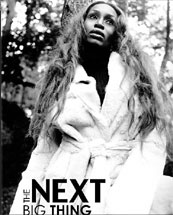 comp card. Whatever your dream is, you have to find a way to make that happen for you. You have to love what you’re doing. I would encourage especially women that want to be in this business, to understand the business-side before you jump in.
comp card. Whatever your dream is, you have to find a way to make that happen for you. You have to love what you’re doing. I would encourage especially women that want to be in this business, to understand the business-side before you jump in.
Where do you see Coco Johnsen 5 years from now?
I see the label growing and hopefully being something that I can be proud of. Eventually being all over the world and being known for the quality that we produce. I don’t mind if we don’t produce or sell as much volume as you might find in a Macy’s or Bloomindale’s. As long as the quality is there and the fit is true to what I am designing for, I’ll be happy with that.
Any last words?
Again, back to starting your business, I’d like to say enjoy your life and appreciate every day, and appreciate your clothes.
To learn more about Coco Johnsen’s designs, visitwww.cocojohnsenboutique.com.
By Kaylene Peoples
Apollonia Kotero – What Has She Done Lately?
Apollonia Kotero – What Has She Done Lately?
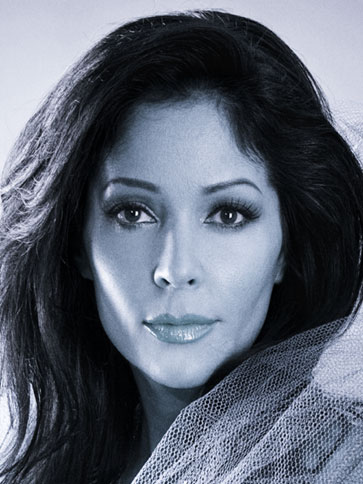 I am not sure how many of you remember the actress/singer Apollonia Kotero. She starred in the oscar-winning movie Purple Rain back in 1984, and had a hit single “Sex Shooter” from her group Apollonia 6. She has appeared in television shows, including Night Rider, Chips, Falcon Crest, and Fantasy Island. She was in the films Back to Back, Black Magic Woman, and Ministry of Vengeance, just to name a few. Her duet with Prince, “Take Me with You,” on the Purple Rain soundtrack ended up becoming her biggest hit to date. But what has Patricia Apollonia Kotero done lately?
I am not sure how many of you remember the actress/singer Apollonia Kotero. She starred in the oscar-winning movie Purple Rain back in 1984, and had a hit single “Sex Shooter” from her group Apollonia 6. She has appeared in television shows, including Night Rider, Chips, Falcon Crest, and Fantasy Island. She was in the films Back to Back, Black Magic Woman, and Ministry of Vengeance, just to name a few. Her duet with Prince, “Take Me with You,” on the Purple Rain soundtrack ended up becoming her biggest hit to date. But what has Patricia Apollonia Kotero done lately?
Last season I was seated next to her at fashion designer Joseph Domingo’s runway show at Fashion Week and was introduced to the beautifully, well-preserved Apollonia. Having seen Purple Rain—I own the sound track—I was very much aware of who Apollonia was. As we chatted before the show, she expressed her like for Joseph Domingo’s designs, as well as mentioning a few other designers she liked. I thought it would be a great idea to shoot her for Agenda Magazine. She agreed, and we had an informal interview, where I learned so much more about this very talented and impassioned woman.
Apollonia, would you mind sharing with our readers what you are up to these days?
I am excited to be attending AFI Woman’s Workshop for directing. Maya Angelou, my idol, has taken the class. I was in AFI in the early 90s. I went through a divorce and lost my focus. So I fell out of school back then.
You have a production company now?
Yes, it’s called Kotero Entertainment. It’s a multi-media production company. I have several lawyers, an agent, and we represent everything from art directors to directors to actors, actresses. . .and I have a little girl who is only 12 and sings like Billie Holiday. We develop scripts.
What led you to develop the company?
There are so many talented people out there without guidance. And I just know what it was like when I was growing up, and how difficult it was for me being a woman/minority. Many 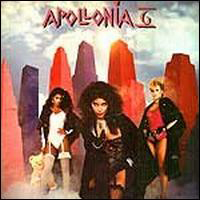 times you don’t know anybody and you’re not related to anybody and it’s really tough. It started off as a mentorship, and it became a full fledged company.
times you don’t know anybody and you’re not related to anybody and it’s really tough. It started off as a mentorship, and it became a full fledged company.
Was it a difficult thing to start?
Not really, I put my mind to it. I always believe in what Shakespeare said, “The company makes the feast,” with the right group of people. You have to be selective, trust the right people, trust [in] their ingenuity, talent, and their integrity.
You had mentioned earlier there have been a lot of things printed. . .some were true some weren’t. Then you mentioned about some of the struggles as a Latina coming up in this industry. I would love to hear a little bit about that, and how you overcame it.
It’s something that I think is pretty universal, being Latina, being first generation. It also goes with the African-American actress—the ghetto gangster, the Latina maid, housekeeper, prostitute. Those are the difficult things I think we all face in this industry. Having to drive from the South Bay to auditions in my car that was falling apart. . .I was driving 5 days a week for casting and auditions; [and I heard things like] well. . . “They went for the all-American girl,” or “You’re not tall enough, or “You don’t really look Latin.” It was really tough, but I was never discouraged. I have the fear of God in me. And my family [encouraged me]. You realize that you’re not the only one going through that, especially for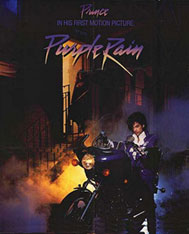 me in the early 80s. Now you have a plethora of different versatile actors from all over the world. There are more Latin shows like Ugly Betty, produced by Salma Hayek, who I adore. It goes on. But it’s taken so many years. When I was cast in the film with Prince, it was just a mysterious woman. I don’t think I’ve really played a Latina. Out of all the parts I played in TV and film, the only time I got to play Latin with a Latin accent was just a few years ago on Air America with Lorenzo Llamas.
me in the early 80s. Now you have a plethora of different versatile actors from all over the world. There are more Latin shows like Ugly Betty, produced by Salma Hayek, who I adore. It goes on. But it’s taken so many years. When I was cast in the film with Prince, it was just a mysterious woman. I don’t think I’ve really played a Latina. Out of all the parts I played in TV and film, the only time I got to play Latin with a Latin accent was just a few years ago on Air America with Lorenzo Llamas.
So you’re saying the face of the industry has changed a lot since the early 80s when you had first gotten involved.
Absolutely. You look at people before that, I don’t remember anybody Latin when I was auditioning before except Ricardo Maltaban and Eric Estrada. I can’t remember someone I looked up to other than the old school stars like Dolores Del Río, Rachel Welch, Freddie Prinz, and Desi Arnaz. But there was nobody out there [who] I [could emulate]. They were older women, not the young hot Latina.
Going back to AFI, is the reason you decided to become a director?which is a huge thing?to maybe help steer Latin-based movies to open the doors for some other actors?
For me, when you start looking at an actor in another extension, the writer becomes the director, the actor becomes the writer/director. It’s always in the same industry. It’s all interconnected. There’s a real chemistry when you write a script. And then you see so many actors/writers who’ve become directors. . . for me, there are only 7 percent of women directing. When you look from Julie Taymor to Penny Marshall, there are just a few. One of the first Latin female directors back in the 40s was Ida Lupino. It took Selma Heyak 10 years to get that movie [ Frida ] shot. She never let go of Frida Kahlo. She was ambitious, and she’d run you over if you didn’t listen.
As far as directing, I’d like to direct all varieties, whether it’s a music video or a comedy piece. It doesn’t have to be a Latino-type story. I was born in Southern California. I live in Hawaii, and I surf (she laughs). So it could be about anything as long as I have a passion for the words on the paper.
Tell me about the jewelry line you’re designing.
I am designing a line of Jewelry with Steven Zale, geared toward ladies of elegance. If you can’t afford to go to Harry Winston, I can provide a great piece of jewelry, which is just as beautiful and just as well-made a design. I’ll have a rings and little pink diamonds that are affordable—jewelry couture. I think you can really tell a lot about a lady by the jewelry that she wears, or doesn’t wear.
What are the price points on some of the pieces?
We really haven’t discussed it, but I want to make sure that it’s something that is affordable. We could do a variety of different pieces at different prices.
This is fine jewelry, then?
Yes. It’s real.
Is there anything else you’d like to add?
I am also [involved with] a movie called the ” Winged Man,” I am helping them as a supporter. [As a supporter I mean that] I’m doing whatever I can to help them out, and I have donated to their cause. It’s a 15-minute short, directed by Marya Mazor, written by Jose´ Rivera; and Anna Ortiz from Ugly Betty is in it.
Apollonia Kotero is heavily involved in Project Angel Food LA, Nosotros, Women in Film, Los Angeles Mission, LULAC, The Violence Intervention Program Los Angeles, and The Wall of Las Memorias. To learn more about Apollonia, visit her websitewww.myspace.com/apolloniakotero.
By Kaylene Peoples
